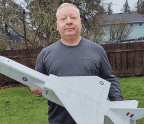QUADZILLA


Yeah, I know. This plane looks like the parent company of the B-17 Flying Fortress, Boeing, decided to build a Reno Racing machine! But really, the Quadzilla was born from my desire for something totally different. I was thinking that everything had been done in RC: helis, jets, scale, pattern—even twin pattern models! So what haven’t I seen before? A four-motor sport pattern ship! This would be a nightmare with glow but easily accomplished with electric power. How to keep it simple? Inexpensive brushed motors would only require one speed control and relatively simple parallel wiring. So using my multi-motor experience and some basic parameters, I conceived Quadzilla with a 50-inch-span with a sheeted-foam wing and basic box-structure fuselage. It uses four Speed 400 or “longcan” 480 motors, a single 45- to 55-amp speed control and a 3-cell, 3700mAh LiPo battery pack.
How does it fly? Very well thank you! Well enough to win “Best Multi-Motor” award when I introduced it at the Mid-America Electric Fly event. With a FlightPower 25C EVO battery, I get 440 watts, and the plane weighs 43 ounces. Its clean airframe really helps it penetrate the wind, and with four 4.75x4.75 APC props, top speed is quite shocking. If four motors seems like overkill to you, the plan also includes nacelles for a
You’re reading a preview, subscribe to read more.
Start your free 30 days





